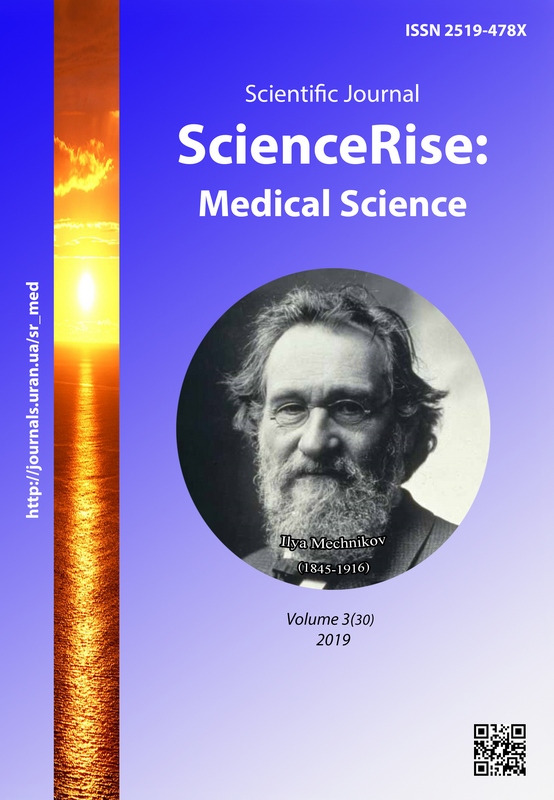Morphological study of aorta in patients with acute aortic syndromes
DOI:
https://doi.org/10.15587/2519-4798.2019.170504Keywords:
aorta, morphological studies, smooth muscle cells, aortic dissection, acute aortic syndromeAbstract
Purpose of the study is to investigate the morphology of the aortic wall in patients with acute aortic syndrome.
Materials and methods. The results of morphological study of aneurysmatic fragments (n-52), which were collected intraoperatively, each fragment were prepared on the basis of the SI "V.T.Zaycev Institute of General and Urgent Surgery AMSU", which were coloured with hematoxilin eosin, elastic fibers/ were incubated with antibodies to IgG, and with Apo-Alert DNA Fragmentation to determine apoptosis.
Results. Post-coarctation aneurysms had the following microscopic picture: a decrease in the medial layer with small fields of disorganization of elastic fibers and smooth muscle cells (SMC). The detection of apoptotic cells in the sections is minimal. In the group of acute aortic dissection aneurysms in 40 % of cases, the elastic fibers were fragmented, the SMC are chaotic with separate parts of the isiocytane medineocrine - a typical pattern for Marfan's syndrome. A microscopic study of thoracoabdominal aneurysms showed a significant decrease in the middle layer with the development of fibrosis. When counting the total number of cells, a decrease in smooth muscle cells was found on average by 54 %. The aneurysms of the abdominal aorta were characterized by major degenerative changes. Reducing the medial layer and fibrous changes were also the most significant. Reduction of the medial layer and fibrous changes were most significant in this group
Conclusions. All types of complicated aneurysms are characterized by insufficiency of smooth muscle cells in aortic wall. The study found that a decrease in the number of smooth muscle cells can occur due to apoptosis. There is a clear correlation with inflammatory infiltration by cells that produce apoptosis inductionReferences
- Bokeriya, L. A., Samuilova, D. Sh., Averina, T. B., Samsonova, N. N. et. al. (2004). Sindrom sistemnogo vospalitelnogo otveta u kardiokhirurgicheskikh bolnykh. [Systemic inflammatory response syndrome in cardiac surgery patient]. Byulleten NTsSSKh im. A. N. Bakuleva RAMN, 5 (12), 2–24.
- Zemtsovskiy, E. V., Malev, E. G. (2012). Malyye anomalii serdtsa i displasticheskiye fenotipy [Minor heart anomalies and dysplastic phenotypes]. Saint Petersburg: Izd-vo «IVESEP», 160.
- Yarilin, A. A.; Moroz, B. B. (Ed.) (2001). Apoptoz: priroda fenomena i ego rol v norme i pri patologii. Aktualnyye problemy patofiziologii [Apoptosis: phenomenon nature and its role in pathology]. Moscow.
- Rudoy, A. S., Uryvaev, A. M. (2015). Syvorotochnyye urovni TGF u patsiyentov s sindromom Marfana i «serologicheskaya tomografiya aorty» [Serum levels of TGF in patients with Marfan Syndrome and “serological tomography of aorta”]. Terapiya–2015, 137.
- Chinov, E. Yu., Mironenko, V. A., Rychin, S. V. et. al. (2014). Khirurgicheskaya korrektsiya dugi aorty pri ostrom rassloyenii aorty 1 tipa [Surgical correction of aortic arch in acute aortic dissection type 1]. Byulleten NTsSSKh im. A. N. Bakuleva RAMN Serdechno-sosudistyye zabolevaniya, 15 (S6), 52.
- Franken, R., den Hartog, A. W., Radonic, T., Micha, D., Maugeri, A., van Dijk, F. S. et. al. (2015). Beneficial Outcome of Losartan Therapy Depends on Type of FBN1 Mutation in Marfan Syndrome. Circulation: Cardiovascular Genetics, 8 (2), 383–388. doi: http://doi.org/10.1161/circgenetics.114.000950
- Vriz, O., Driussi, C., Bettio, M., Ferrara, F., D’Andrea, A., Bossone, E. (2013). Aortic Root Dimensions and Stiffness in Healthy Subjects. The American Journal of Cardiology, 112 (8), 1224–1229. doi: http://doi.org/10.1016/j.amjcard.2013.05.068
- Krüger, T., Oikonomou, A., Schibilsky, D., Lescan, M., Bregel, K., Vöhringer, L. et. al. (2016). Aortic leght and the risk of dissection. The Tubingen Aortic Pathoanatomy (TAIPAN) Project. EACTS Daily News, 2, 14.
- Lam, C. S. P., Xanthakis, V., Sullivan, L. M., Lieb, W., Aragam, J., Redfield, M. M. et. al. (2010). Aortic Root Remodeling Over the Adult Life Course. Circulation, 122 (9), 884–890. doi: http://doi.org/10.1161/circulationaha.110.937839
- Detaint, D., Michelena, H. I., Nkomo, V. T., Vahanian, A., Jondeau, G., Sarano, M. E. (2013). Aortic dilatation patterns and rates in adults with bicuspid aortic valves: a comparative study with Marfan syndrome and degenerative aortopathy. Heart, 100 (2), 126–134. doi: http://doi.org/10.1136/heartjnl-2013-304920
Downloads
Published
How to Cite
Issue
Section
License
Copyright (c) 2019 Olga Buchnieva

This work is licensed under a Creative Commons Attribution 4.0 International License.
Our journal abides by the Creative Commons CC BY copyright rights and permissions for open access journals.
Authors, who are published in this journal, agree to the following conditions:
1. The authors reserve the right to authorship of the work and pass the first publication right of this work to the journal under the terms of a Creative Commons CC BY, which allows others to freely distribute the published research with the obligatory reference to the authors of the original work and the first publication of the work in this journal.
2. The authors have the right to conclude separate supplement agreements that relate to non-exclusive work distribution in the form in which it has been published by the journal (for example, to upload the work to the online storage of the journal or publish it as part of a monograph), provided that the reference to the first publication of the work in this journal is included.









